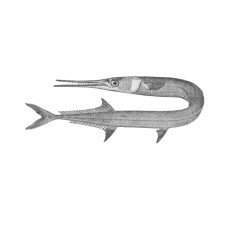Latin name
Tylosurus acus
Other name
Keel-jawed needlefish
Identification
The three subspecies have been given species rank as tentatively accepted names pending further work on the identification of T. acus to consolidate their status.
Vertebrae: 90-95. Body elongate. Upper and lower jaws are extremely long, forming a thick beak armed with very sharp teeth. Gill stamens are absent. Nostrils in a recess in front of the eyes.
Features of fish fins
Dorsal spines (total): 0; Dorsal soft rays (total): 20-27; Anal spines: 0; Anal soft rays: 20-24. Anal fin short. Caudal fin deeply forked.
Fish colouring
Have a small black lateral keel on each side of the caudal spine.
Distribution
Widespread in the Atlantic and Indo-Pacific Oceans. Western Atlantic: from Massachusetts, USA to Brazil. Eastern Atlantic: from Morocco to the Mediterranean.
Habitat
A marine species associated with reefs. Depth from 0 to 100 meters. Prefers a subtropical climate: 43°N, 98°W, 36°E.
Size
Maximum length 153 cm, normal length 90.0 cm. Maximum declared weight 3.7 kg.
Behavior
They live in oceanic and coastal waters.
Food and feeding habits
They feed on small fish.
Reproduction
The eggs of these fish can be found attached to objects in the water by tendrils on the surface.
Fishing
This species is of commercial importance.
Relationship with a person
The market for this species is limited due to the green color of the flesh. Agujon needlefish are poisonous to humans.
| Classification | |
| Phylum | Chordata |
| Class | Actinopterygii |
| Squad | Beloniformes |
| Family | Belonidae |
| Genus | Tylosurus |
| Species | T. acus |
| Features | |
| Conservation status | Least Concern |
| Habitat | Pelagic |
| Life span, years | No information |
| Maximum body weight, kg | 3,7 |
| Maximum length, cm | 153 |
| Sailing speed, m/s | No information |
| Threat to people | Edible |
| Way of eating | Predator |
Agujon needlefish
Tags: agujon needlefish

